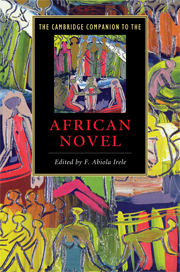Book contents
- Frontmatter
- 1 Introduction: perspectives on the African novel
- 2 The oral-literate interface
- 3 Chinua Achebe and the African novel
- 4 Protest and resistance
- 5 The Afrikaans novel
- 6 The African novel in Arabic
- 7 The francophone novel in North Africa
- 8 The francophone novel in sub-Saharan Africa
- 9 The African historical novel
- 10 Magical realism and the African novel
- 11 The African novel and the feminine condition
- 12 Autobiography and Bildungsroman in African literature
- 13 The postcolonial condition
- 14 New voices, emerging themes
- 15 The critical reception of the African novel
- Bibliography
- Index
5 - The Afrikaans novel
Published online by Cambridge University Press: 28 January 2010
- Frontmatter
- 1 Introduction: perspectives on the African novel
- 2 The oral-literate interface
- 3 Chinua Achebe and the African novel
- 4 Protest and resistance
- 5 The Afrikaans novel
- 6 The African novel in Arabic
- 7 The francophone novel in North Africa
- 8 The francophone novel in sub-Saharan Africa
- 9 The African historical novel
- 10 Magical realism and the African novel
- 11 The African novel and the feminine condition
- 12 Autobiography and Bildungsroman in African literature
- 13 The postcolonial condition
- 14 New voices, emerging themes
- 15 The critical reception of the African novel
- Bibliography
- Index
Summary
Early European settlement of South Africa was a piecemeal affair. The Portuguese were the first to round the Cape in the late fifteenth century, leaving us as reminders of their presence a number of stone crosses and a canto of Camoens’s epic poem, The Lusiads. The Dutch Vereenigde Oost- Indische Compagnie (VOC), established a permanent outpost in the region in 1652, intending to restock ships plying the lucrative trade between Europe and the East. Within a decade, Company servants had become full-time farmers, and these early settlers had entered into conflict with the indigenous Khoikhoi. A trickle of Dutch and German immigrants was bolstered in 1688 by the arrival of French Huguenots fleeing religious persecution in Europe. From 1658, slaves were imported from both coasts of Africa, Madagascar, Indonesia and Sri Lanka. In 1806 the British took final control of the Cape, fearing its strategic position might be used against them by Napoleon. Organized migration from Britain followed in the 1820s, and, after diamonds and gold were discovered in the second half of the century, the region saw a steady influx of mostly British and Commonwealth immigrants. South African settlers thus fell largely into two groups: English speakers, most of whom maintained strong ties with Britain and other parts of its empire; and those who spoke Dutch, or a version of it, a group of mixed origins whose affiliations with Europe were largely severed by the nature of their migration, and by later recolonization by Britain.
- Type
- Chapter
- Information
- The Cambridge Companion to the African Novel , pp. 69 - 84Publisher: Cambridge University PressPrint publication year: 2009
- 3
- Cited by



